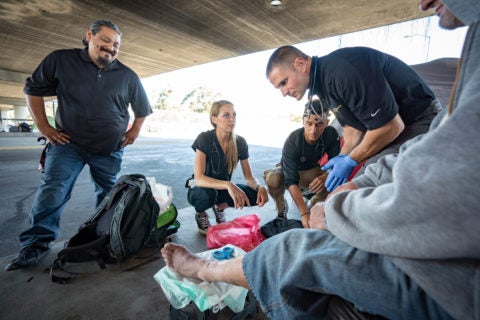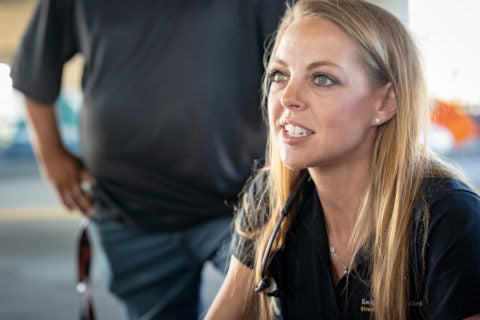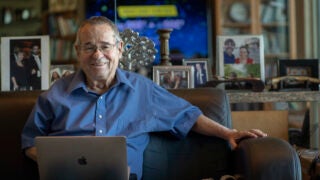
Brett Feldman, Eddie Menacho and Gabrielle Johnson work as part of the Street Medicine team at USC in 2019. (Photo/Chris Shinn)
USC’s Street Medicine team brings the hospital to the homeless
Staffers spend their days combing the streets of Los Angeles, building rapport with patients and providing the in-person medical care they so desperately need.
Nurse Gabrielle Johnson grabs a backpack bursting with medical supplies from the backseat of her Chevy Colorado and jogs across under a freeway overpass in Boyle Heights to see her first patient. Brett Feldman, a physician assistant, is right alongside her.
“Hey Bill!” Johnson called out toward a group of tents on the left side of the road. They find Bill, 49, sitting in a chair between two tents. It’s loud — the noise of thousands of cars careening below.
Feldman and Johnson are part of the Keck School of Medicine of USC’s Street Medicine team. Housed within the Department of Family Medicine, the team’s sole job is to serve people living on the streets — whether that’s providing care, which they do daily, or consulting as specialists at USC’s hospitals.
The program is just over a year old, but it speaks to the need in Los Angeles and the state: There are 45,000 unsheltered homeless people in Los Angeles County alone. Although there are similar programs across the state and U.S. — usually run out of clinics — USC’s Street Medicine team is unique in that it wasn’t started with grant funding and has dedicated daily staff. That, Feldman said, speaks to the school’s commitment to the work.

On most days, Johnson and Feldman are accompanied by community health worker Joseph Becerra, who has experienced homelessness in the past. Becerra watches out for them as they provide aid and also builds rapport with the community, offering socks or other everyday needs. They’re the three full-timers. They also do rounds with Corinne Feldman, a physician assistant at USC and Brett Feldman’s wife, and Department Chair Jehni Robinson, a physician.
Bill’s latest stint on the streets has lasted about five years. And as is the case with many of the patients they see — from Boyle Heights to Pomona and Westwood — they’re performing primary care. Some of it is acute, like dressing wounds, checking vitals and addressing infections. But they also treat chronic conditions, such as monitoring blood-glucose levels and providing medications for diabetes patients. In Bill’s case, it’s caring for abscesses caused by not injecting methamphetamines safely.
“He’s been using so long, he’s essentially blown all his veins,” Feldman said. “He almost shoots blind into his calf and gets abscesses everywhere.”
Feldman also emphasizes that Bill isn’t a stereotype: 15% of people on the streets are drug users, according to a recent point-in-time count by the Los Angeles Homeless Services Authority.
They check on Bill a couple times a month, treating infections. When he sees them today, almost on autopilot he starts removing his lace-up work boots and socks. Johnson lays a blue pad out on the sidewalk where she lines up all her supplies: syringes to wash out the wounds, antiseptic, Band-Aids and Coband, a wrap that holds up better to the elements.
They have a rapport with regulars like Bill. “You’re not putting in windows this week?” Johnson asked. “Nah, I did that last week,” Bill said.
Last week, he worked six days — installing windows and screens. Doing it off and on for the last couple years, his boss drops by on a truck, relatively unannounced, for a day’s work. He’s paid under the table, about $60 plus lunch. He gets shuttled all over L.A., installing in developments in Azusa, the Hollywood Hills and Glendale. Between the work day and driving around in traffic, he’s gone up to 10 hours.
Homelessness is a very complex thing, and we believe the solution is building a health community around people.
Brett Feldman
Feldman asks Bill how he cooks his meth. “I’m just thinking of different things that cause infection and what we can do to make it safer,” Feldman said.
Bill cooks his meth with bottled water but he uses a cigarette filter to filter it, which he plunges the needle into before injecting. That cigarette butt was likely found on the ground. Feldman noted that this technique is common on the streets.
“We’ll give you some alcohol swabs,” Feldman said. And they encourage him to go to a needle exchange for both new needles but also safe injection supplies, like a sterile filter.
“I need to stop slamming all together,” Bill said. “It’s not working out. It’s killing me.”
Team goal: Reduce ER visits for the homeless
Once they meet a patient, they’re following up on all aspects of medical care, checking off every box they can to get them help.
“Homelessness is a very complex thing, and we believe the solution is building a health community around people,” Feldman said. “It doesn’t have to wait until they’re housed to do that. Part of our holistic approach is beginning to build that community around them.”
In the case of Bill, they find out he’s intellectually disabled and therefore eligible for state benefits.
“They’re supposed to provide supports forever, but once you become homeless, there’s not much they can do,” Feldman said. It’s hard to locate homeless people who are usually lacking an address, identification and a phone.
Johnson has been playing phone tag with Bill’s caseworker in the South Bay — where Bill used to live — hoping to get his case transferred to Los Angeles, where Johnson will physically take Bill or send him via Uber. During their half-hour visit, she calls the center again. She knows some of his details by heart by now. What she doesn’t know, she turns to him and asks.

Johnson carries a journal around to keep track of all of her patients, which she later transfers to the medical record. They actively manage 70 patients, visiting them weekly or monthly. About a dozen cases require additional follow-ups, such as Larry, a veteran with basal cell carcinoma that’s eating a third of his nose. They want to make an appointment with Veterans Affairs to come out and fill any gap in paperwork he may have so he can receive medical care, including surgery. But all this can be an uphill climb. They can’t pressure their patients to show up to appointments or follow through.
Street medicine programs have been shown to reduce visits to the emergency room. Lehigh Valley Health Network in Pennsylvania, where Feldman led a street medicine program, saw an 80% reduction in visits to the ER with the patients his team saw. Although USC doesn’t yet have data in that regard, it’s a team goal to reduce emergency room visits, especially with homeless individuals who can already be doctor avoidant.
For example, the team has a patient named Mario. When they first met him, he lived in a bridge in Boyle Heights, going in and out of a manhole cover.
“He had the largest apartment in L.A.,” Feldman said. “It’s about 100 feet down the bridge.”
Now Mario lives in an RV on the streets, sometimes with his girlfriend. When it comes to his health, he’s been through a lot. While working his day job, he put a drill bit through his hand, which got infected at the bone.
About six weeks ago, he hopped over a guard rail, not seeing the 20-foot drop on the other side. He ended up with fractures in both legs. He now has external metal rods on both his legs. During a recent visit, it was clear he should go to the ER: The rod insertion sites were looking iffy. His girlfriend even told him to. But he was reluctant. After taking a look with Feldman, Johnson told Mario she would go to the hospital later that afternoon to make an appointment in person.
“The problem is the risk is so high,” Feldman said. “Those rods go right into the bone. If he gets an infection, it can go directly to the bone and lead to amputation.”
How the Street Medicine team views its patients
The Street Medicine team knows the impact housing would have on their patients’ health.
There’s not a lot of research, but Feldman pointed to a recent study in JAMA that showed the rate of mortality for unsheltered homeless is three times that of those sheltered. And while the life expectancy of women and men is 83 and 79 in California, on the streets it’s much lower, according to the L.A. Times. The average in L.A. County is 48 years for homeless women and 51 years for homeless men.
The overwhelming majority of homeless patients do want housing, Feldman said. It’s just complicated to leave a culture they’ve cultivated on the streets, even if it’s an unhealthy one.
Bill has been off and on the streets for the better part of a decade. His sobriety has a lot to do with it. He grew up in the foster care system and said he was bullied as a kid for developmental delays and for being in special education classes. At home, he was berated by his foster father, who physically abused him.
Just like other doctors, we get referrals from one bridge to the next.
Feldman
When he was 14, someone asked him if he had ever tried speed. “That’s probably how I became an addict,” he said. Later, as an adult, he got sucked into crack — losing his fiancée, his home.
Feldman and Johnson remember the first time they met Bill. They were treating a friend of his named Bullet, who lived in a dumpster in Boyle Heights.
“He walked up and asked, ‘Can you fix this?’” Johnson said.
“Just like other doctors,” Feldman said, “we get referrals from one bridge to the next.”
Difficulties in treating the homeless
You have to be a special kind of clinician to do the work this team does.
“Sometimes we’re crawling into holes, crawling into buildings,” Feldman said. “If I know my patient is in there and they can’t get out, then that’s where I need to go.”

For some physicians, going from the sterile clinic to the not so sterile streets can be jarring.
“I’ve had clinicians come — very experienced — and they’re coming to the camp and what they see is very different than what I see,” Feldman said. “They see the medical problems, but they don’t see the patient being sex trafficked. They don’t see who might be the alpha in the camp, who isn’t allowing them to leave at certain times, which means appointments can’t happen at certain times. They don’t know what to look for and it’s disorienting. There’s definitely a fog of war element to it.”
The Street Medicine team is also thinking of how elements of the streets impact their patients’ care, such as dirt and rain.
“The medications we give out are all in blister packs, so they’re individually dosed and resistant to weather,” Feldman said.
This comes up in the hospital as well, where Feldman consults as a specialist — just like a cardiologist or neurologist might. On a recent day, after meeting with patients on the streets he was headed to an afternoon appointment with a woman with metastatic ovarian cancer, who is homeless.
“She’s just agreed to chemotherapy, which will mean frequent visits, so the trick is going to be to get her someplace stable away from the dangers of the street,” he said. “What we find is that when [homeless] folks are diagnosed, they are diagnosed much later. When something may have been curable, it’s no longer. And when they are connected to treatment, they can’t stay in it.”
And surgeons are cautious because this population is at risk for postoperative infection and hard to follow-up with, Feldman said. That means being homeless can disqualify you from life-saving treatment.
“Part of our job is to close that inequity gap,” he said.
During the consult, he’ll see what her version of homelessness looks like — if she lives in a community, has access to basic necessities and if she could get to the potentially life-saving treatment she’s agreed to. If she doesn’t, he has to make a case why she can’t be discharged. Sometimes he’s making that case to the physician, sometimes to the patient.
“She might think she’s perfectly fine to be outside, because she was before, and not understand the reality of the present circumstances,” he said. “We’re the bridge from the hospital to the street, because we know what the hospital is like and we know what the streets are like.”
A leader in street medicine
Feldman was recruited to start the Street Medicine team two years ago after doing it for roughly 14 years in Pennsylvania, where he founded two street medicine programs and won a number of awards. He’s also vice chair of The Street Medicine Institute, which provides training and support for street medicine programs internationally and helped implement and improve programs in 85 cities across 15 countries. This summer, Feldman led USC’s first L.A. Street Medicine Symposium at the Health Sciences Campus to demystify the concept and encourage others across the region and the U.S. to try street medicine. Basically, Feldman is a leader nationally — if not internationally —in street medicine.

Crouched down on the curb next to Bill, Johnson reminds Bill that they’re to help.
“You’re not alone when you do it,” Johnson said. “We can get you somewhere. We can help.”
Given his health condition, Johnson said she could get him into a treatment center within two days, maybe the same day.
“You don’t need me to tell you, but it’s really hard to get sober out here,” Feldman added. “Now it’s housing first — they get you housing then get you sober.”
As they wrap up, Bill asked about the regional center.
“We’re kind of in limbo,” Johnson told him. His case is being passed around in the South Bay. Her goal is to get a phone appointment on the books with the South Bay caseworker, an L.A. caseworker and Bill. She’ll come to his spot under the overpass to do the call.
They’ll be back to see later this week. As they pack up their backpacks, Johnson makes a list of things Bill needs. Feldman reiterates what he said earlier.
“Think about what we talked about — with the housing,” he said.
With Bill’s 50th birthday in September, maybe it could be an early gift to himself.



